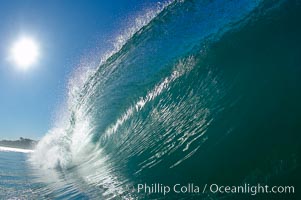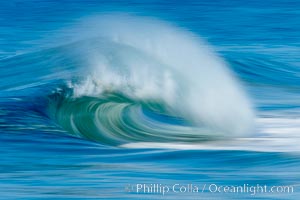
Breaking wave, fast motion and blur, The Wedge.
Location: The Wedge, Newport Beach, California
Image ID: 14355
Location: The Wedge, Newport Beach, California
Image ID: 14355
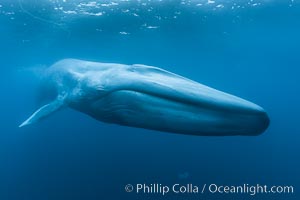
Blue whale underwater closeup photo. This picture of a blue whale, the largest animal ever to inhabit earth, shows it swimming through the open ocean, a rare underwater view. Since this blue whale was approximately 80-90' long and just a few feet from the camera, an extremely wide lens was used to photograph the entire enormous whale.
Species: Blue whale, Balaenoptera musculus
Location: California
Image ID: 27299
Species: Blue whale, Balaenoptera musculus
Location: California
Image ID: 27299
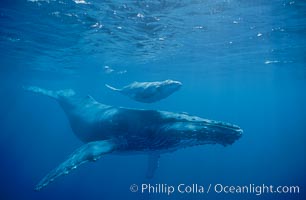
North Pacific humpback whales, a mother and calf pair swim closely together just under the surface of the ocean. The calf will remain with its mother for about a year, migrating from Hawaii to Alaska to feed on herring.
Species: Humpback whale, Megaptera novaeangliae
Location: Maui, Hawaii
Image ID: 00140
Species: Humpback whale, Megaptera novaeangliae
Location: Maui, Hawaii
Image ID: 00140
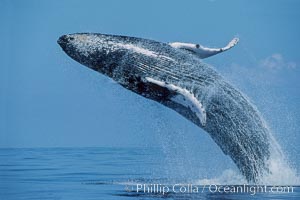
Humpback whale breaching, near Molokai, Hawaii. Megaptera novaeangliae. It is suspected the breaching often has a communicative purpose which depends on the behavioral context of the moment.
Species: Humpback whale, Megaptera novaeangliae
Location: Maui, Hawaii
Image ID: 00205
Species: Humpback whale, Megaptera novaeangliae
Location: Maui, Hawaii
Image ID: 00205
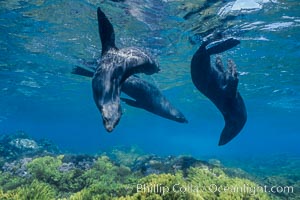
Guadalupe fur seals, floating upside down underwater over a rocky reef covered with golden kelp at Guadalupe Island.
Species: Guadalupe fur seal, Arctocephalus townsendi
Location: Guadalupe Island (Isla Guadalupe), Baja California, Mexico
Image ID: 02113
Species: Guadalupe fur seal, Arctocephalus townsendi
Location: Guadalupe Island (Isla Guadalupe), Baja California, Mexico
Image ID: 02113
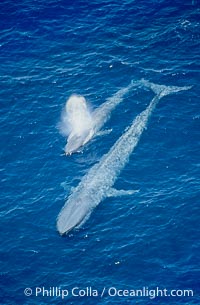
Two blue whales, a mother and her calf, swim through the open ocean in this aerial photograph. The calf is blowing (spouting, exhaling) with a powerful column of spray. The blue whale is the largest animal ever to live on Earth.
Species: Blue whale, Balaenoptera musculus
Location: San Diego, California
Image ID: 02304
Species: Blue whale, Balaenoptera musculus
Location: San Diego, California
Image ID: 02304
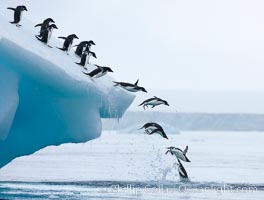
Adelie penguins leaping into the ocean from an iceberg.
Species: Adelie penguin, Pygoscelis adeliae
Location: Brown Bluff, Antarctic Peninsula, Antarctica
Image ID: 25005
Species: Adelie penguin, Pygoscelis adeliae
Location: Brown Bluff, Antarctic Peninsula, Antarctica
Image ID: 25005
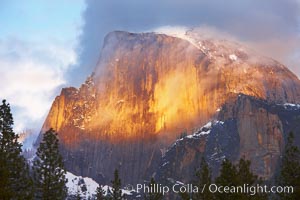
Half Dome and storm clouds at sunset, viewed from Sentinel Bridge.
Location: Half Dome, Yosemite National Park, California
Image ID: 22744
Location: Half Dome, Yosemite National Park, California
Image ID: 22744
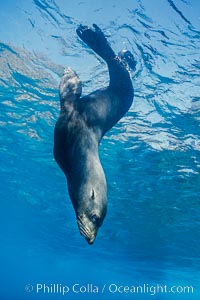
Guadalupe fur seal, floating upside down under the ocean's surface at Guadalupe Island, watching the photographer and looking for passing predators.
Species: Guadalupe fur seal, Arctocephalus townsendi
Location: Guadalupe Island (Isla Guadalupe), Baja California, Mexico
Image ID: 02114
Species: Guadalupe fur seal, Arctocephalus townsendi
Location: Guadalupe Island (Isla Guadalupe), Baja California, Mexico
Image ID: 02114
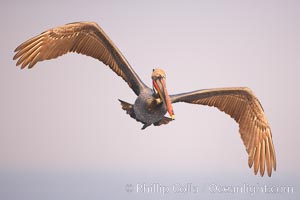
Brown pelican in flight against pastel-colored sky at sunrise. The wingspan of the brown pelican is over 7 feet wide. The California race of the brown pelican holds endangered species status. In winter months, breeding adults assume a dramatic plumage.
Species: Brown Pelican, Pelecanus occidentalis, Pelecanus occidentalis californicus
Location: La Jolla, California
Image ID: 15122
Species: Brown Pelican, Pelecanus occidentalis, Pelecanus occidentalis californicus
Location: La Jolla, California
Image ID: 15122
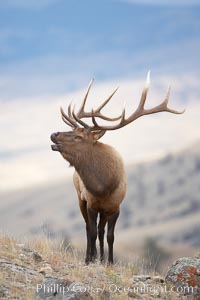
Male elk bugling during the fall rut. Large male elk are known as bulls. Male elk have large antlers which are shed each year. Male elk engage in competitive mating behaviors during the rut, including posturing, antler wrestling and bugling, a loud series of screams which is intended to establish dominance over other males and attract females.
Species: Elk, Cervus canadensis
Location: Mammoth Hot Springs, Yellowstone National Park, Wyoming
Image ID: 19693
Species: Elk, Cervus canadensis
Location: Mammoth Hot Springs, Yellowstone National Park, Wyoming
Image ID: 19693
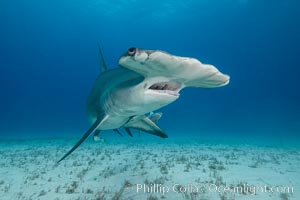
Great hammerhead shark.
Species: Great hammerhead shark, Sphyrna mokarran
Location: Bimini, Bahamas
Image ID: 31966
Species: Great hammerhead shark, Sphyrna mokarran
Location: Bimini, Bahamas
Image ID: 31966
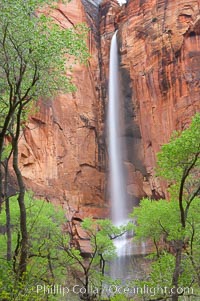
Waterfall at Temple of Sinawava during peak flow following spring rainstorm. Zion Canyon.
Location: Temple of Sinawava, Zion National Park, Utah
Image ID: 12450
Location: Temple of Sinawava, Zion National Park, Utah
Image ID: 12450
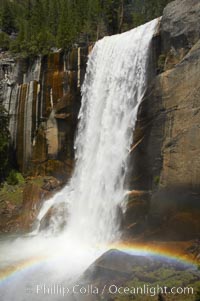
Vernal Falls at peak flow in late spring, with a rainbow appearing in the spray of the falls, viewed from the Mist Trail.
Location: Vernal Falls, Yosemite National Park, California
Image ID: 12634
Location: Vernal Falls, Yosemite National Park, California
Image ID: 12634
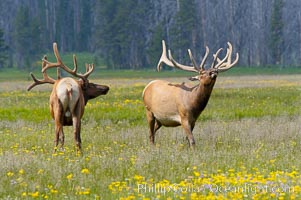
Bull elk spar to establish harems of females, Gibbon Meadow.
Species: Elk, Cervus canadensis
Location: Gibbon Meadows, Yellowstone National Park, Wyoming
Image ID: 13151
Species: Elk, Cervus canadensis
Location: Gibbon Meadows, Yellowstone National Park, Wyoming
Image ID: 13151
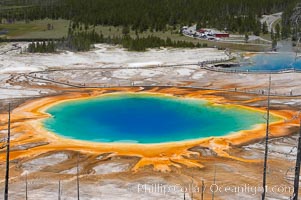
Grand Prismatic Spring (left) and Excelsior Geyser (right). Grand Prismatic Spring displays a stunning rainbow of colors created by species of thermophilac (heat-loving) bacteria that thrive in narrow temperature ranges. The blue water in the center is too hot to support any bacterial life, while the outer orange rings are the coolest water. Grand Prismatic Spring is the largest spring in the United States and the third-largest in the world. Midway Geyser Basin.
Location: Midway Geyser Basin, Yellowstone National Park, Wyoming
Image ID: 13571
Location: Midway Geyser Basin, Yellowstone National Park, Wyoming
Image ID: 13571
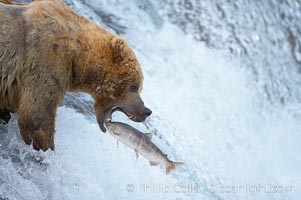
Alaskan brown bear catching a jumping salmon, Brooks Falls.
Species: Brown bear, Ursus arctos
Location: Brooks River, Katmai National Park, Alaska
Image ID: 17031
Species: Brown bear, Ursus arctos
Location: Brooks River, Katmai National Park, Alaska
Image ID: 17031
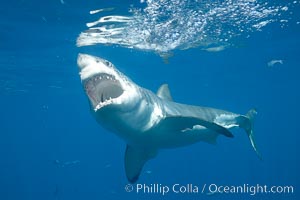
A great white shark opens it mouth just before it attacks its prey with a crippling, powerful bite. After the prey has been disabled, the shark will often wait for it to weaken from blood loss before resuming the attack. If the shark looses a tooth in the course of the bite, a replacement just behind it will move forward to take its place.
Species: Great white shark, Carcharodon carcharias
Location: Guadalupe Island (Isla Guadalupe), Baja California, Mexico
Image ID: 19452
Species: Great white shark, Carcharodon carcharias
Location: Guadalupe Island (Isla Guadalupe), Baja California, Mexico
Image ID: 19452
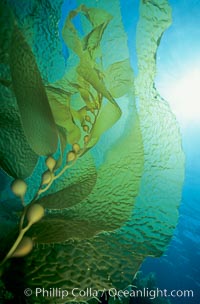
Kelp frond showing pneumatocysts.
Species: Giant kelp, Macrocystis pyrifera
Location: San Clemente Island, California
Image ID: 00627
Species: Giant kelp, Macrocystis pyrifera
Location: San Clemente Island, California
Image ID: 00627
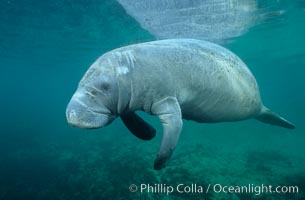
A Florida manatee, or West Indian Manatee, swims slowly through the clear waters of Crystal River.
Species: West indian manatee, Trichechus manatus
Location: Three Sisters Springs, Crystal River, Florida
Image ID: 02696
Species: West indian manatee, Trichechus manatus
Location: Three Sisters Springs, Crystal River, Florida
Image ID: 02696
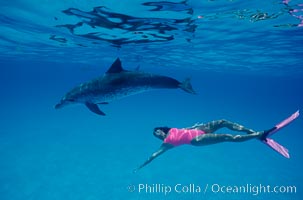
Atlantic spotted dolphin, Olympic swimmer Mikako Kotani.
Species: Atlantic spotted dolphin, Stenella frontalis
Location: Bahamas
Image ID: 00647
Species: Atlantic spotted dolphin, Stenella frontalis
Location: Bahamas
Image ID: 00647
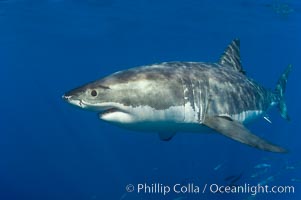
A great white shark swims through the clear waters of Isla Guadalupe, far offshore of the Pacific Coast of Baja California. Guadalupe Island is host to a concentration of large great white sharks, which visit the island to feed on pinnipeds and tuna.
Species: Great white shark, Carcharodon carcharias
Location: Guadalupe Island (Isla Guadalupe), Baja California, Mexico
Image ID: 07666
Species: Great white shark, Carcharodon carcharias
Location: Guadalupe Island (Isla Guadalupe), Baja California, Mexico
Image ID: 07666
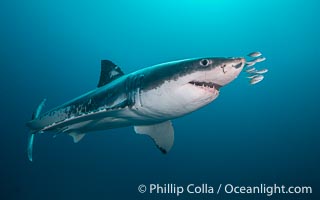
Great White Shark, South Neptune Islands, South Australia.
Species: Great white shark, Carcharodon carcharias
Location: South Neptune Islands, South Australia
Image ID: 39139
Species: Great white shark, Carcharodon carcharias
Location: South Neptune Islands, South Australia
Image ID: 39139
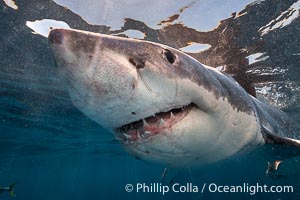
Great White Shark, South Neptune Islands, South Australia.
Species: Great white shark, Carcharodon carcharias
Location: South Neptune Islands, South Australia
Image ID: 39140
Species: Great white shark, Carcharodon carcharias
Location: South Neptune Islands, South Australia
Image ID: 39140
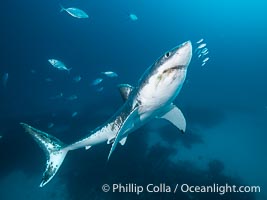
Great White Shark, South Neptune Islands, South Australia.
Species: Great white shark, Carcharodon carcharias
Location: South Neptune Islands, South Australia
Image ID: 39141
Species: Great white shark, Carcharodon carcharias
Location: South Neptune Islands, South Australia
Image ID: 39141
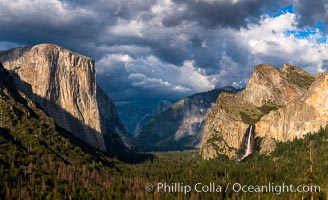
Yosemite Valley Tunnel View, Storm clouds at sunset, Yosemite National Park.
Location: Yosemite National Park, California
Image ID: 34542
Panorama dimensions: 7653 x 12541
Location: Yosemite National Park, California
Image ID: 34542
Panorama dimensions: 7653 x 12541
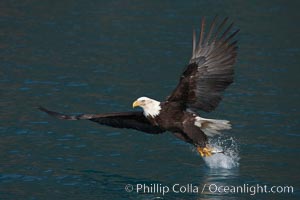
Bald eagle makes a splash while in flight as it takes a fish out of the water.
Species: Bald eagle, Haliaeetus leucocephalus, Haliaeetus leucocephalus washingtoniensis
Location: Kenai Peninsula, Alaska
Image ID: 22584
Species: Bald eagle, Haliaeetus leucocephalus, Haliaeetus leucocephalus washingtoniensis
Location: Kenai Peninsula, Alaska
Image ID: 22584
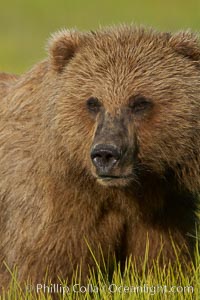
Portrait of a young brown bear, pausing while grazing in tall sedge grass. Brown bears can consume 30 lbs of sedge grass daily, waiting weeks until spawning salmon fill the rivers.
Species: Brown bear, Ursus arctos
Location: Lake Clark National Park, Alaska
Image ID: 19135
Species: Brown bear, Ursus arctos
Location: Lake Clark National Park, Alaska
Image ID: 19135
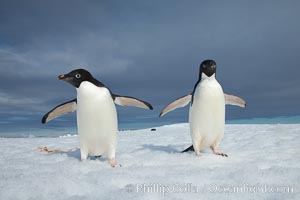
Two Adelie penguins, holding their wings out, standing on an iceberg.
Species: Adelie penguin, Pygoscelis adeliae
Location: Paulet Island, Antarctic Peninsula, Antarctica
Image ID: 25007
Species: Adelie penguin, Pygoscelis adeliae
Location: Paulet Island, Antarctic Peninsula, Antarctica
Image ID: 25007
